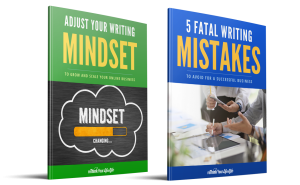
Finding a balance between what your customer wants and what you want to do can be like walking a very shaky tightrope sometimes. You know you should find out more about your customer, about where they are in the consumer buying process and therefore what products or services they actually want -- but you really want to just build that whatchamadoodle and sell it. Right?
Teachers, this is like when you're super excited about teaching that book you loved in high school, the one that changed your life, and the 15-year-olds sitting in your class just yawn and roll their eyes. If you're lucky. Or maybe you spend hours developing this amazing lesson plan and some kid says, "This is the dumbest assignment I've ever seen!"
Yeah, it stings. But you have to talk to the kids, find out what went wrong, and then look at who is in front of your right now, what they need, and what you have to offer.
This works the same way with marketing -- and in both cases, it's often easy to forget that. Especially in online marketing when your customer isn't sitting right in front of you and maybe is too polite to tell you that the watchamadoodle you're trying to sell them isn't going to solve the problem they're facing right now.
But all hope doesn't have to be lost in either case if you also know that reflecting, asking for help, and taking action on what you learn is a huge key to business success.
Not only do I know this, but I'm also not ashamed to turn to my mentors for help when I see that I need it. Kelly offered up an opportunity to "ask me anything" a few weeks ago and so I jumped at the chance. I submitted my question for her consideration.
And she answered on her blog!
Kelly's answer also made me thing of the consumer buying process. Basically, when a customer is considering purchasing a product, they go through six steps. The process looks something like this:

Graphic provided by TrackMaven.
- 1Problem recognition: The customer realizes they have a problem. Maybe it's that their lawn is looking a little ragged and they have no time to mow. Or their house smells a little stale from being closed up all winter. Or they're needing a side gig, but have no idea where to start. They aren't ready to buy anything yet, but may be ready to find other people in their communities with similar problems.
- 2Information search: This is where the customer may start asking friends for advice, or looking for information online. They may read articles or blog posts. They may sign up for your mailing list and download your free report. But they're not buying your landscaping services, scented candles, or WordPress skills course yet. This is where you can provide blog posts, guest articles/podcast interviews, or free reports that will provide them with the information they need.
- 3Evaluation of alternatives: This is where they start looking at specific solutions. Maybe they compare one lawn care company to another. Maybe they're trying to decided if they want a candle burner, wax melts, room freshener spray, or a fresh coat of paint on the walls. Maybe they're trying to decide if they should really start a business or just go get another job. This might be where you can capture their attention with a blog post comparing and contrasting those alternatives for them.
- 4Purchase decision: Your customer is now ready to buy something, whether it's an online course to help them learn a skill or change their mindset, lawn care services so they don't get a notice from the city, or a candle warmer so they can make their house smell nice without setting anything on fire.
- 5Purchase: This is where they customer makes that purchase -- from you if you've guided them through the rest of this process. This is why you need to have a sales funnel that takes all of these steps into consideration.
- 6Post-purchase evaluation: Most of the customer buying process models I've researched haven't included this step. But it's like the post-lesson assessment and reflection of a good lesson plan. Not only is your customer going to be reflecting on the wisdom of their purchase, but you need to make sure you're they're to guide them through this evaluation. How do they use what they bought? How can the best benefit from it? Where do they need to go to get answers? What other solutions are you offering?
Kelly has certainly given me a lot to think about -- and I hope her answer for me has helped you, too.
Not only that, but I also won a free month of coaching with her. I can't wait to learn and grow so that we can all work together to succeed in our businesses!
Looking for more advice to help you create content to serve your community?
Take our writing survey below to learn more about our Writing for Entrepreneurs Course! Then download our free reports!


